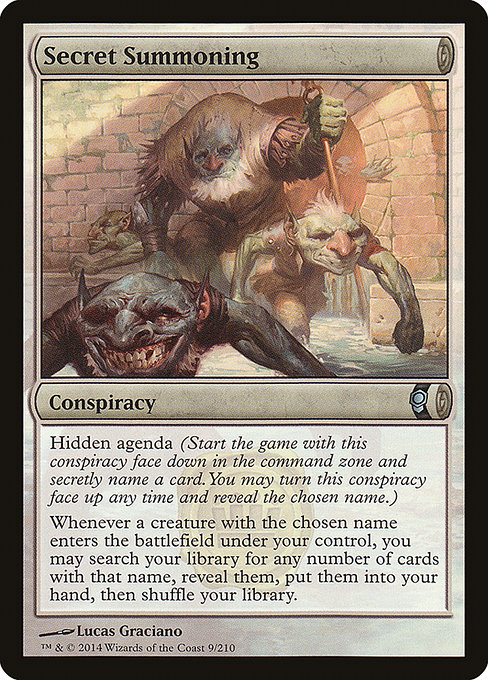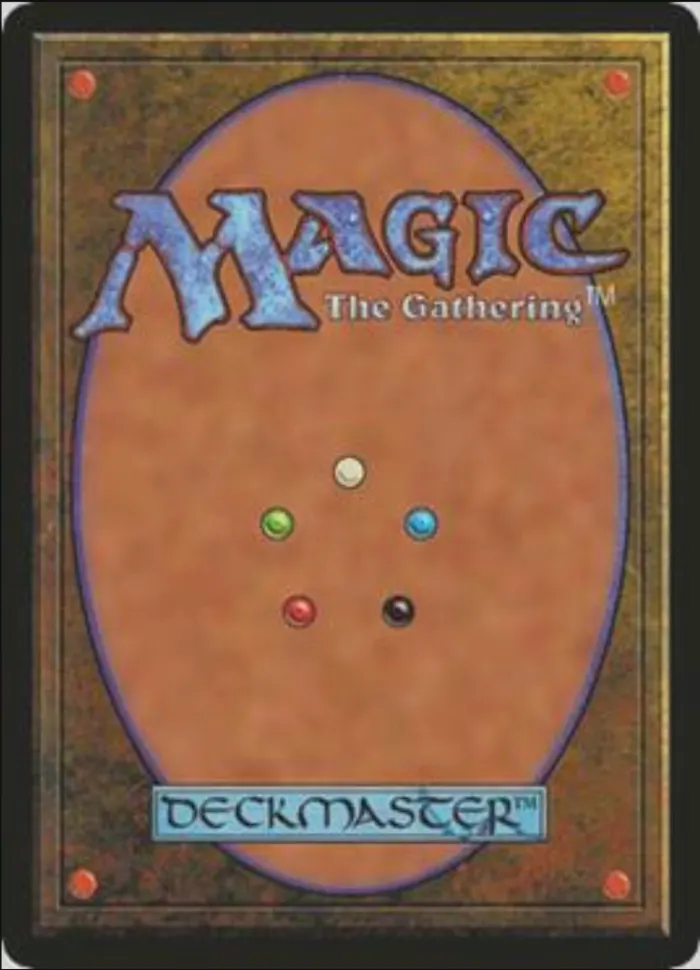standard
future
historic
gladiator
pioneer
explorer
modern
pauper
penny
brawl
alchemy
paupercommander
oldschool
premodern
Rulings
A conspiracy doesn’t count as a card in your deck for purposes of meeting minimum deck size requirements. (In most drafts, the minimum deck size is 40 cards.)
You name the card as the game begins, as you put the conspiracy into the command zone, not as you turn the face-down conspiracy face up.
A conspiracy’s static and triggered abilities function as long as that conspiracy is face-up in the command zone.
You can look at any player’s face-up conspiracies at any time. You’ll also know how many face-down conspiracies a player has in the command zone, although you won’t know what they are.
Conspiracies aren’t legal for any sanctioned Constructed format, but may be included in other Limited formats, such as Cube Draft.
If you play multiple games after the draft, you can name a different card in each new game.
As a special action, you may turn a face-down conspiracy face up. You may do so any time you have priority. This action doesn’t use the stack and can’t be responded to. Once face up, the named card is revealed and the conspiracy’s abilities will affect the game.
You don’t have to play with any conspiracy you draft. However, you have only one opportunity to put conspiracies into the command zone, as the game begins. You can’t put conspiracies into the command zone after this point.
You must name a Magic card. Notably, you can’t name a token (except in the unusual case that a token’s name matches the name of a card, such as Illusion).
At the end of the game, you must reveal any face-down conspiracies you own in the command zone to all players.
Conspiracies are colorless, have no mana cost, and can’t be cast as spells.
At the end of the game, you must reveal any face-down conspiracies you own in the command zone to all players. Notably, you can’t bluff conspiracies with hidden agenda by putting other cards into the command zone face down as the game starts.
A conspiracy with hidden agenda that has a triggered ability must be face up before that ability’s trigger condition is met in order for it to trigger. Turning it face up afterward won’t have any effect.
There are several ways to secretly name a card, including writing the name on a piece of paper that’s kept with the face-down conspiracy. If you have multiple face-down conspiracies, you may name a different card for each one. It’s important that each named card is clearly associated with only one of the conspiracies.
Conspiracies are never put into your deck. Instead, you put any number of conspiracies from your card pool into the command zone as the game begins. These conspiracies are face up unless they have hidden agenda, in which case they begin the game face down.
You name the card as the game begins, as you put the conspiracy into the command zone, not as you turn the face-down conspiracy face up.
A conspiracy’s static and triggered abilities function as long as that conspiracy is face-up in the command zone.
You can look at any player’s face-up conspiracies at any time. You’ll also know how many face-down conspiracies a player has in the command zone, although you won’t know what they are.
Conspiracies aren’t legal for any sanctioned Constructed format, but may be included in other Limited formats, such as Cube Draft.
If you play multiple games after the draft, you can name a different card in each new game.
As a special action, you may turn a face-down conspiracy face up. You may do so any time you have priority. This action doesn’t use the stack and can’t be responded to. Once face up, the named card is revealed and the conspiracy’s abilities will affect the game.
You don’t have to play with any conspiracy you draft. However, you have only one opportunity to put conspiracies into the command zone, as the game begins. You can’t put conspiracies into the command zone after this point.
You must name a Magic card. Notably, you can’t name a token (except in the unusual case that a token’s name matches the name of a card, such as Illusion).
At the end of the game, you must reveal any face-down conspiracies you own in the command zone to all players.
Conspiracies are colorless, have no mana cost, and can’t be cast as spells.
At the end of the game, you must reveal any face-down conspiracies you own in the command zone to all players. Notably, you can’t bluff conspiracies with hidden agenda by putting other cards into the command zone face down as the game starts.
A conspiracy with hidden agenda that has a triggered ability must be face up before that ability’s trigger condition is met in order for it to trigger. Turning it face up afterward won’t have any effect.
There are several ways to secretly name a card, including writing the name on a piece of paper that’s kept with the face-down conspiracy. If you have multiple face-down conspiracies, you may name a different card for each one. It’s important that each named card is clearly associated with only one of the conspiracies.
Conspiracies are never put into your deck. Instead, you put any number of conspiracies from your card pool into the command zone as the game begins. These conspiracies are face up unless they have hidden agenda, in which case they begin the game face down.
Rulings
A conspiracy doesn’t count as a card in your deck for purposes of meeting minimum deck size requirements. (In most drafts, the minimum deck size is 40 cards.)
You name the card as the game begins, as you put the conspiracy into the command zone, not as you turn the face-down conspiracy face up.
A conspiracy’s static and triggered abilities function as long as that conspiracy is face-up in the command zone.
You can look at any player’s face-up conspiracies at any time. You’ll also know how many face-down conspiracies a player has in the command zone, although you won’t know what they are.
Conspiracies aren’t legal for any sanctioned Constructed format, but may be included in other Limited formats, such as Cube Draft.
If you play multiple games after the draft, you can name a different card in each new game.
As a special action, you may turn a face-down conspiracy face up. You may do so any time you have priority. This action doesn’t use the stack and can’t be responded to. Once face up, the named card is revealed and the conspiracy’s abilities will affect the game.
You don’t have to play with any conspiracy you draft. However, you have only one opportunity to put conspiracies into the command zone, as the game begins. You can’t put conspiracies into the command zone after this point.
You must name a Magic card. Notably, you can’t name a token (except in the unusual case that a token’s name matches the name of a card, such as Illusion).
At the end of the game, you must reveal any face-down conspiracies you own in the command zone to all players.
Conspiracies are colorless, have no mana cost, and can’t be cast as spells.
At the end of the game, you must reveal any face-down conspiracies you own in the command zone to all players. Notably, you can’t bluff conspiracies with hidden agenda by putting other cards into the command zone face down as the game starts.
A conspiracy with hidden agenda that has a triggered ability must be face up before that ability’s trigger condition is met in order for it to trigger. Turning it face up afterward won’t have any effect.
There are several ways to secretly name a card, including writing the name on a piece of paper that’s kept with the face-down conspiracy. If you have multiple face-down conspiracies, you may name a different card for each one. It’s important that each named card is clearly associated with only one of the conspiracies.
Conspiracies are never put into your deck. Instead, you put any number of conspiracies from your card pool into the command zone as the game begins. These conspiracies are face up unless they have hidden agenda, in which case they begin the game face down.
You name the card as the game begins, as you put the conspiracy into the command zone, not as you turn the face-down conspiracy face up.
A conspiracy’s static and triggered abilities function as long as that conspiracy is face-up in the command zone.
You can look at any player’s face-up conspiracies at any time. You’ll also know how many face-down conspiracies a player has in the command zone, although you won’t know what they are.
Conspiracies aren’t legal for any sanctioned Constructed format, but may be included in other Limited formats, such as Cube Draft.
If you play multiple games after the draft, you can name a different card in each new game.
As a special action, you may turn a face-down conspiracy face up. You may do so any time you have priority. This action doesn’t use the stack and can’t be responded to. Once face up, the named card is revealed and the conspiracy’s abilities will affect the game.
You don’t have to play with any conspiracy you draft. However, you have only one opportunity to put conspiracies into the command zone, as the game begins. You can’t put conspiracies into the command zone after this point.
You must name a Magic card. Notably, you can’t name a token (except in the unusual case that a token’s name matches the name of a card, such as Illusion).
At the end of the game, you must reveal any face-down conspiracies you own in the command zone to all players.
Conspiracies are colorless, have no mana cost, and can’t be cast as spells.
At the end of the game, you must reveal any face-down conspiracies you own in the command zone to all players. Notably, you can’t bluff conspiracies with hidden agenda by putting other cards into the command zone face down as the game starts.
A conspiracy with hidden agenda that has a triggered ability must be face up before that ability’s trigger condition is met in order for it to trigger. Turning it face up afterward won’t have any effect.
There are several ways to secretly name a card, including writing the name on a piece of paper that’s kept with the face-down conspiracy. If you have multiple face-down conspiracies, you may name a different card for each one. It’s important that each named card is clearly associated with only one of the conspiracies.
Conspiracies are never put into your deck. Instead, you put any number of conspiracies from your card pool into the command zone as the game begins. These conspiracies are face up unless they have hidden agenda, in which case they begin the game face down.
Votre collection ? vos decks ?
Envie de gérer votre collection et/ou créer des decks ?


 0
0
 0.10€
0.10€